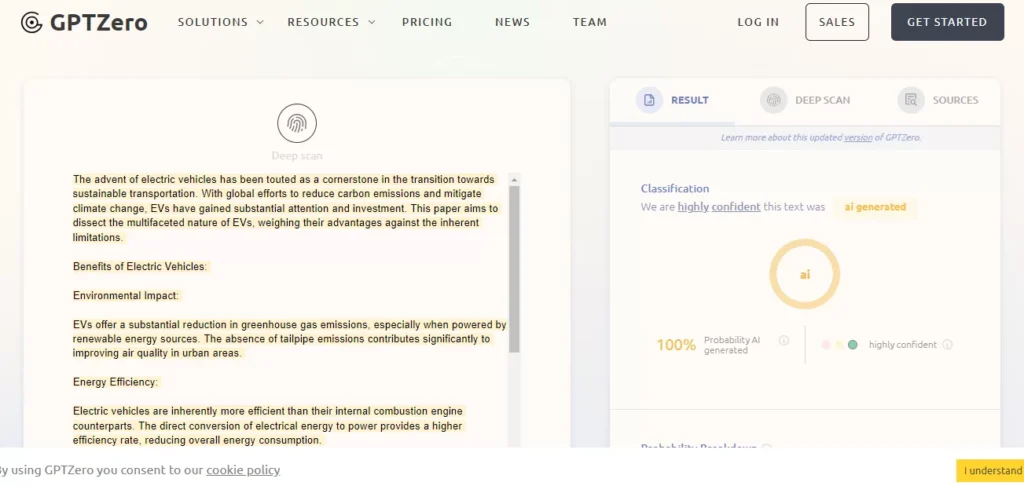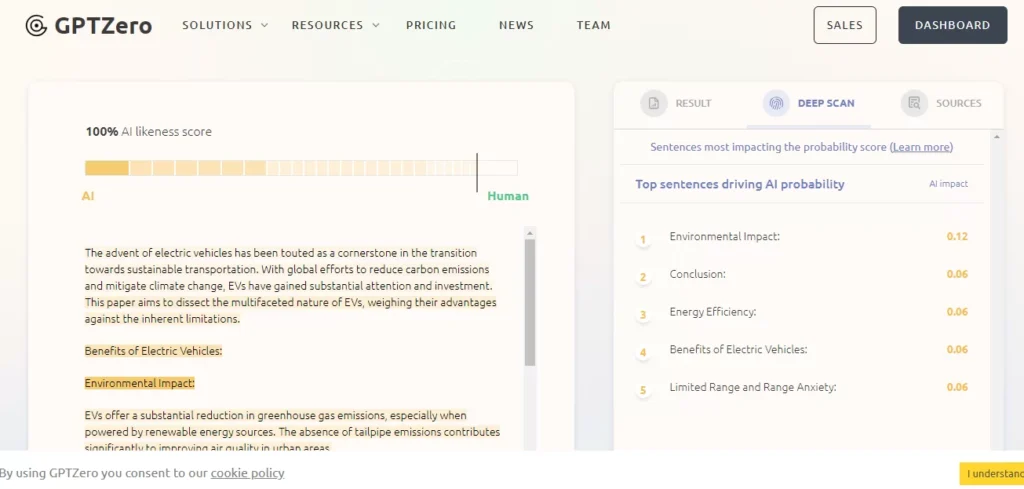GPTZero serves as a detection tool for AI-generated text from large language models (LLMs) like ChatGPT, Gemini, Copilot, and Meta AI, including GPT (Generative Pre-trained Transformer) developed by OpenAI.
These models, such as GPT, have significantly impacted natural language processing tasks such as translation, question answering, and text completion by generating human-like responses based on extensive training with large text datasets.
Despite their usefulness, concerns have emerged regarding the potential misuse of these models across various sectors for generating fake news, spam, and other undesirable content.
To address these concerns about bias and misuse, OpenAI has proposed a conceptual model named GPTzero, which would start with a clean slate, devoid of pre-existing parameters or weights.
This approach allows GPTzero to be trained from scratch, potentially offering a solution to mitigate bias and misuse concerns associated with existing large language models.
In an article, the functionality and limitations of the GPTZero AI Detector are discussed, shedding light on its role in identifying AI-generated text and its capabilities in combating potential misuse of language models.
GPTZero AI Detector
GPTZero AI Detector is an AI text analyzer tool developed by Edward Tian, a computer science graduate, with the goal of aiding professors and instructors in distinguishing between plagiarized text and original work.
The tool achieves this by examining perplexity and burstiness in a text to determine if it was artificially generated or created by a human.
Functioning as a classification model, GPTZero predicts whether a document was authored by a large language model. It provides predictions at different levels, including sentence, paragraph, and document levels. The tool’s training data consists of a vast and diverse collection of human-written and AI-generated text, with a particular emphasis on English prose.
Does GPTZero only detect outputs from ChatGPT?
GPTZero is not limited to detecting outputs from ChatGPT alone. It works effectively across a variety of AI language models, including ChatGPT, GPT-3, GPT-2, LLaMA, and other AI services based on these models.
How Does GPTZero Work?
The tool assesses each AI-written document with a score, indicating the likelihood of the entire document being AI-generated. This scoring system assists users in determining the extent of AI influence in the text.
When dealing with documents that combine AI-generated and human-written content, the tool employs sentence-level classification. Detecting a single flagged AI-written sentence doesn’t automatically classify the entire document as partially AI-generated. However, a substantial portion marked as AI-generated does pinpoint the relevant section within the text.
The primary goal of the classifier is to pinpoint instances where additional investigation and caution regarding AI-generated content are warranted.
Its applicability spans across education, certification, hiring and recruitment, social writing platforms, and scenarios where plagiarism or disinformation are potential concerns.
GPTzero’s role in detecting ChatGPT-generated research articles
GPTzero plays a crucial role in identifying research articles produced by ChatGPT. Although ChatGPT, created by OpenAI, can generate well-structured and informative research articles across diverse subjects, researchers and academics have expressed concerns regarding potential plagiarism in certain articles generated by ChatGPT.
4 Steps to Using the GPTZero AI Detection Tool
GPTzero AI Detector functions as an AI detection tool specifically designed to distinguish text generated by AI models like ChatGPT, Bing Chat, Meta AI, Gemini, Copilot, and other large language models.
It’s available as a free online tool aiding users in determining whether a given piece of text is human-written or AI-generated.
Here’s how GPTzero’s working procedure unfolds in four steps:
Text Input:
Users input the text they want to analyze into the GPTZero website or API.

2. Analysis:
GPTZero’s algorithm scrutinizes the text, identifying patterns and characteristics commonly associated with AI-generated text.

3. Scoring:
The tool assigns a score indicating the likelihood of AI generation based on the analyzed text.

4. Result:
The output displays the score alongside a confidence level, indicating the probability of AI generation for the analyzed text.

AI Detection Methodology
GPTZero utilizes various techniques for AI detection, including:
1. Statistical Analysis
GPTZero utilizes statistical analysis to evaluate various aspects of text, including sentence structure, word choice, and linguistic patterns. This analysis helps in identifying potential AI-generated content based on statistical anomalies.
2. Machine Learning
The tool employs machine learning techniques to train models for recognizing patterns specific to AI-generated text. By learning from a diverse dataset, GPTZero becomes adept at distinguishing between human-written and AI-generated content.
3. N-gram Analysis
N-gram analysis is another method used by GPTZero to analyze sequences of words in the text. This approach helps in identifying recurring patterns and structures that are indicative of AI-generated text.
Flagging Similarities
If GPTZero detects significant similarities between a ChatGPT-generated research article and a known research article, it flags the content for further review by human moderators. This step ensures thorough verification of the research article’s originality and authenticity before it is cited or referenced.
Disadvantages of GPTZero AI Detector
Here are the drawbacks of GPTZero AI Detector:
- Evolution of AI Models: AI researchers are constantly improving AI models, which can lead to changes in the characteristics of AI-generated text. This evolution may challenge GPTZero’s ability to accurately detect newer versions of AI-generated content.
- False Positives and False Negatives: GPTZero may incorrectly identify human-written text as AI-generated (false positives) or fail to detect AI-generated text (false negatives). These errors can impact the reliability of the detection process.
- Paraphrasing and Rewording: GPTZero faces challenges in accurately detecting paraphrased or reworded content, as these variations may not align perfectly with known patterns of AI-generated text.
- Continuous Improvement: Being a relatively new technology, GPTZero is still in the early stages of development. There is room for improvement and refinement in the detection algorithm to enhance accuracy and reliability over time.
Takeaways about GPTZero
Here are the key takeaways about GPTZero:
- Detection Tool: GPTZero is a hypothetical version of OpenAI’s GPT model designed specifically for detecting AI-generated research articles.
- Zero Pre-Existing Parameters: Unlike other models, GPTZero has no pre-existing parameters or weights, making it a unique tool for detection purposes.
- Detection Capabilities: GPTZero can identify articles generated by ChatGPT, Copilot, Gemini, and Meta AI that contain plagiarized content.
- Limitations: While valuable, GPTZero’s detection algorithm is not perfect and may not be 100% accurate.
- Fight Against Fake News: GPTZero represents an important step in combating fake news, spam, and other undesirable content typically generated by AI language models.
Other articles
Please read through some of our other articles with examples and explanations if you’d like to learn more.
Tools
- QuillBot
- Paraphraser.io
- Imagestotext.io
- Websites to Read Books for Free
- Tools to Convert PNG Image to Excel
- Detect AI-Generated Text using ZeroGPT and Transform It using Quillbot
- How is QuillBot used in Academic Writing?
- Tools for Presentations
- AI Tools for Citation Management
- Improve your Writing with QuillBot and ChatGPT
- Tools Transforming Knowledge Management
- Plagiarism Checkers Online
- Information Management Software
- Tools for Information Management
- Software Tools for Writing Thesis
- OpenAI WordPress Plugin
- TTS Voiceover
- Backend Automation Testing Tools
- AI Tools for Academic Research
Tech Hacks
Technology
- Shorten the Content’s Length Without Lossing its Meaning
- Write Scientific Research Paper Using Google Bard AI
- Google Bard Can Create Spreadsheets
- How AI Technology is Helpful For Marketers
- How AI Chatbots Can Identify Trading Patterns
- Quorum vs Hyperledger Fabric vs R3 Corda
- ChatGPT vs. Google Bard
- Quantum Apocalypse
- Firmware and Software
- Synergy vs. KVM Switches
- Flash Drive Vs Pen Drive
- Type A, B and C USB Cable
- WSN and IoT
- eSourcing and eProcurement
- Difference between eProcurement and Traditional Procurement
- Neuralink
- ReactJS
- Over the Top and Video On Demand
- Software Development Life Cycle Vs Software Testing Life Cycle
- Software Development Team vs Freelancer
- HDMI over IP vs HDBaseT
- Display Stream Compression
- Top Internet of Things Journals
- Supervised Learning vs. Unsupervised Learning
- Video Upscaling and Video Downscaling
- How To Build a Distributed System
- How to Get Into Data Science From a Non-Technical Background?
- How To Build Ethereum Mining Rig?
ChatGPT
- Paraphrase Text
- PowerPoint Slides
- Learn Languages
- Write Code in Python
- Write Literature Review
- Document Review
- Job Interview Preparation
- Prompts For Students
- Write Cover Letter
- Write Resume
- Write Code
- Job Applications
- Write SQL Queries
- Write Excel Formulas
- Academic Writing
- Translate Text
- Keyword Research
- Business Idea Generation
- Business Entrepreneur
- Use ChatGPT on WhatsApp
- Virtual Research Assistant
- Meta-Analysis in Research
- Large Documents
- Hypothesis Development
- Share ChatGPT Responses
- Text Analysis
- Upload PDF on ChatGPT
- Books ChatGPT


